TOYOTA RAV4 PHEV 2021 Owners Manual
Manufacturer: TOYOTA, Model Year: 2021, Model line: RAV4 PHEV, Model: TOYOTA RAV4 PHEV 2021Pages: 666, PDF Size: 161.28 MB
Page 141 of 666
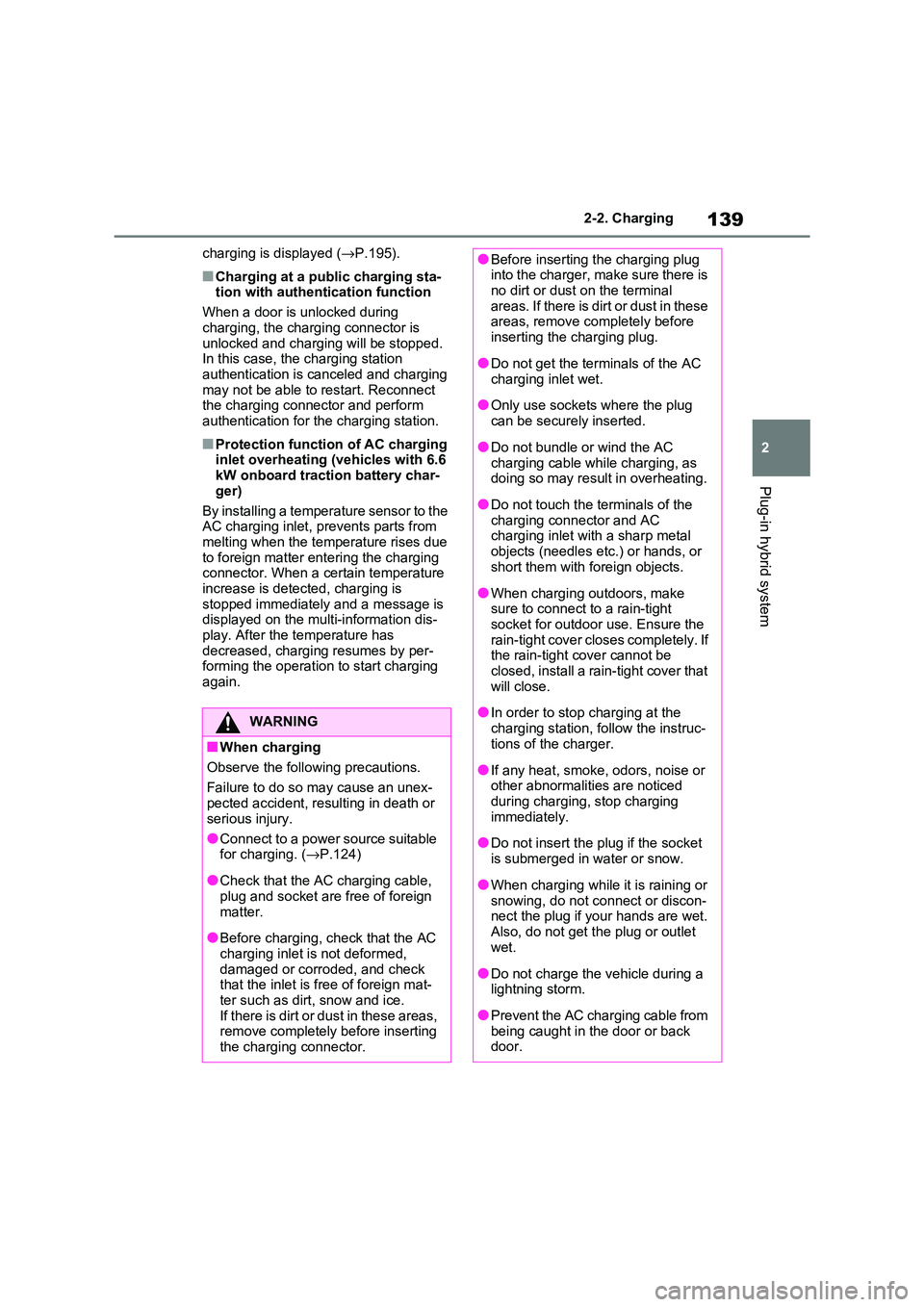
139
2
2-2. Charging
Plug-in hybrid system
charging is displayed ( →P.195).
■Charging at a public charging sta-
tion with authenti cation function
When a door is unlocked during
charging, the charging connector is
unlocked and chargi ng will be stopped. In this case, the charging station
authentication is canceled and charging
may not be able to restart. Reconnect the charging connector and perform
authentication for the charging station.
■Protection function of AC charging
inlet overheating (vehicles with 6.6 kW onboard traction battery char -
ger)
By installing a temperature sensor to the AC charging inlet, prevents parts from
melting when the temperature rises due
to foreign matter ent ering the charging connector. When a certain temperature
increase is detected, charging is
stopped immediately and a message is displayed on the multi-information dis -
play. After the temperature has
decreased, charging resumes by per - forming the operation to start charging
again.
WARNING
■When charging
Observe the following precautions.
Failure to do so may cause an unex -
pected accident, resulting in death or
serious injury.
●Connect to a power source suitable
for charging. ( →P.124)
●Check that the AC charging cable,
plug and socket are free of foreign
matter.
●Before charging, check that the AC
charging inlet is not deformed, damaged or corroded, and check
that the inlet is fr ee of foreign mat-
ter such as dirt , snow and ice. If there is dirt or dust in these areas,
remove completely before inserting
the charging connector.
●Before inserting the charging plug into the charger, make sure there is
no dirt or dust on the terminal
areas. If there is dirt or dust in these areas, remove completely before
inserting the charging plug.
●Do not get the terminals of the AC
charging inlet wet.
●Only use sockets where the plug
can be securely inserted.
●Do not bundle or wind the AC
charging cable while charging, as
doing so may result in overheating.
●Do not touch the te rminals of the
charging connector and AC charging inlet with a sharp metal
objects (needles etc.) or hands, or
short them with foreign objects.
●When charging ou tdoors, make
sure to connect to a rain-tight socket for outdoor u se. Ensure the
rain-tight cover closes completely. If
the rain-tight cover cannot be closed, install a rain-tight cover that
will close.
●In order to stop charging at the
charging station, f ollow the instruc-
tions of the charger.
●If any heat, smoke , odors, noise or
other abnormaliti es are noticed during charging, stop charging
immediately.
●Do not insert the plug if the socket
is submerged in water or snow.
●When charging while it is raining or
snowing, do not connect or discon -
nect the plug if your hands are wet.
Also, do not get the plug or outlet wet.
●Do not charge the vehicle during a lightning storm.
●Prevent the AC charging cable from being caught in the door or back
door.
Page 142 of 666
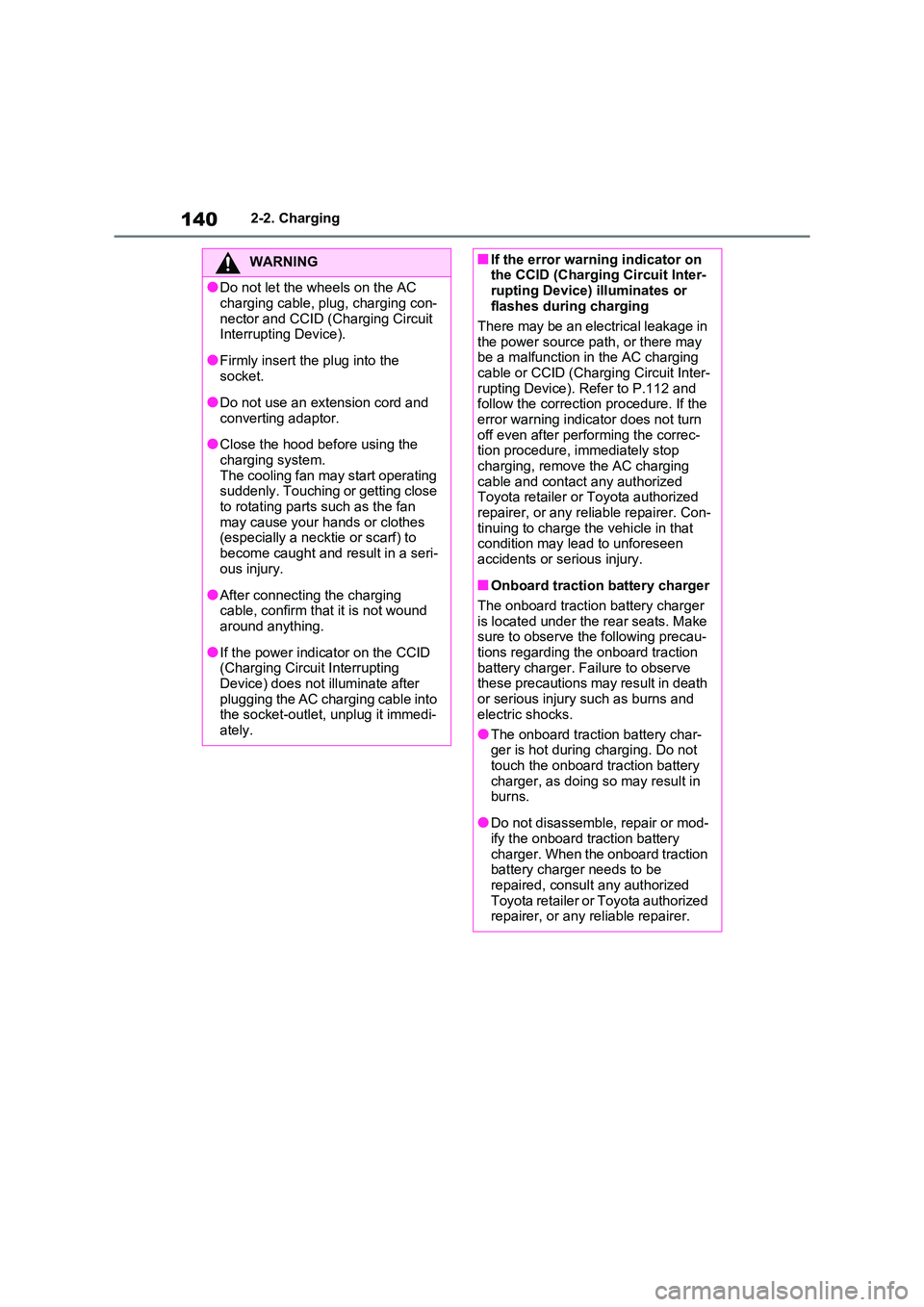
1402-2. Charging
WARNING
●Do not let the wheels on the AC
charging cable, plug, charging con -
nector and CCID (C harging Circuit Interrupting Device).
●Firmly insert the plug into the socket.
●Do not use an ex tension cord and
converting adaptor.
●Close the hood bef ore using the
charging system. The cooling fan may start operating
suddenly. Touching or getting close
to rotating parts such as the fan may cause your hands or clothes
(especially a neckt ie or scarf) to
become caught and result in a seri - ous injury.
●After connecting the charging cable, confirm that it is not wound
around anything.
●If the power indica tor on the CCID
(Charging Circuit Interrupting
Device) does not illuminate after plugging the AC charging cable into
the socket-outlet, unplug it immedi -
ately.
■If the error warnin g indicator on the CCID (Charging Circuit Inter -
rupting Device) illuminates or
flashes during charging
There may be an electrical leakage in
the power source path, or there may
be a malfunction in the AC charging cable or CCID (Cha rging Circuit Inter-
rupting Device). Refer to P.112 and
follow the correcti on procedure. If the error warning indicator does not turn
off even after performing the correc -
tion procedure, immediately stop charging, remove the AC charging
cable and contact any authorized
Toyota retailer or Toyota authorized repairer, or any reliable repairer. Con -
tinuing to charge the vehicle in that
condition may le ad to unforeseen accidents or serious injury.
■Onboard traction battery charger
The onboard traction battery charger
is located under the rear seats. Make
sure to observe the following precau- tions regarding the onboard traction
battery charger. Failure to observe
these precautions may result in death or serious injury such as burns and
electric shocks.
●The onboard traction battery char - ger is hot during charging. Do not
touch the onboard traction battery
charger, as doing so may result in burns.
●Do not disassemble, repair or mod - ify the onboard traction battery
charger. When the onboard traction
battery charger needs to be repaired, consult any authorized
Toyota retailer or Toyota authorized
repairer, or any reliable repairer.
Page 143 of 666
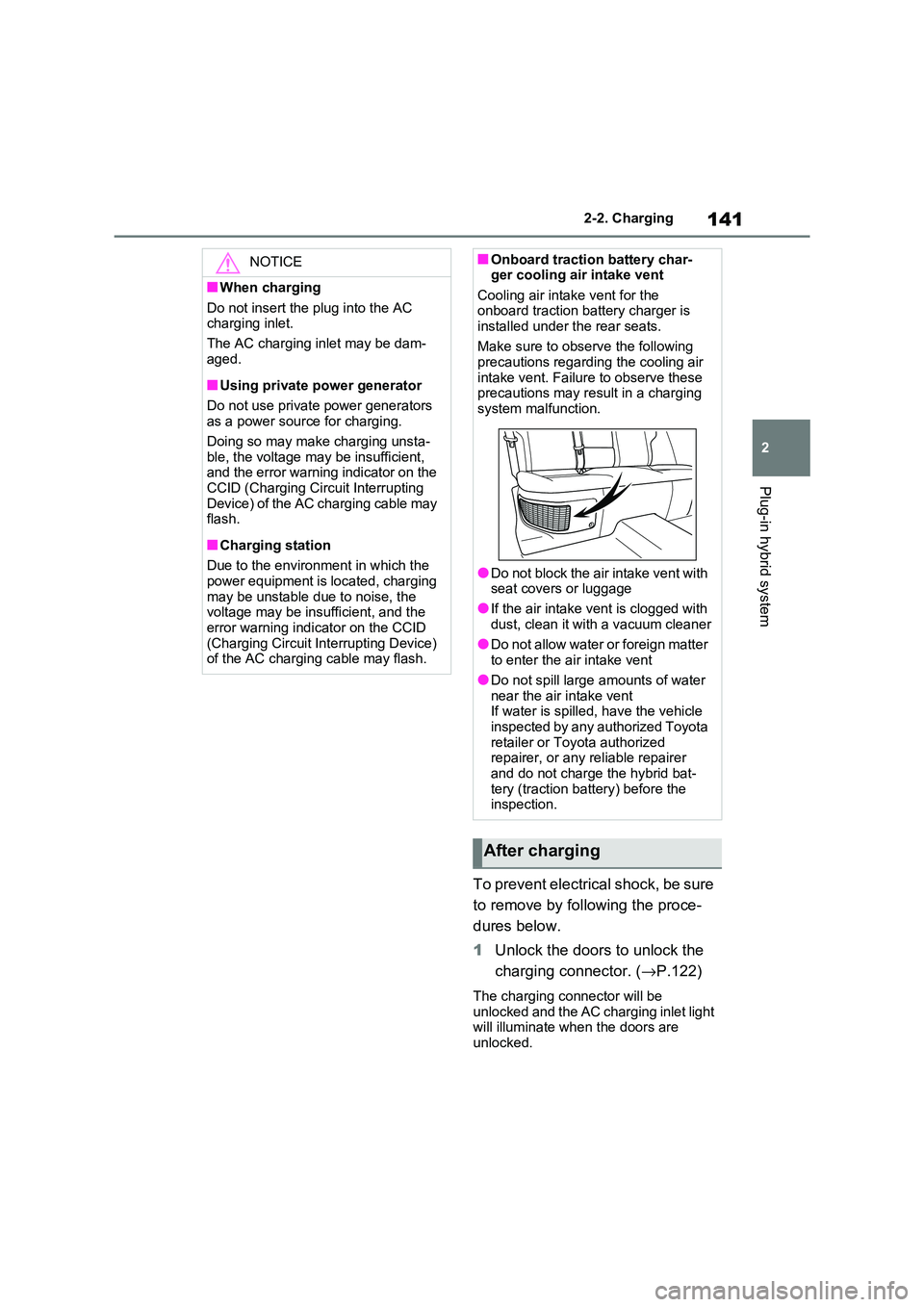
141
2
2-2. Charging
Plug-in hybrid system
To prevent electrical shock, be sure
to remove by following the proce -
dures below.
1 Unlock the doors to unlock the
charging connector. ( →P.122)
The charging connector will be
unlocked and the AC charging inlet light will illuminate when the doors are
unlocked.
NOTICE
■When charging
Do not insert the plug into the AC
charging inlet.
The AC charging inlet may be dam -
aged.
■Using private power generator
Do not use private power generators
as a power source for charging.
Doing so may mak e charging unsta- ble, the voltage may be insufficient,
and the error warning indicator on the
CCID (Charging Circuit Interrupting Device) of the AC charging cable may
flash.
■Charging station
Due to the environment in which the
power equipment is located, charging may be unstable due to noise, the
voltage may be insu fficient, and the
error warning indi cator on the CCID (Charging Circuit Interrupting Device)
of the AC charging cable may flash.
■Onboard traction battery char- ger cooling air intake vent
Cooling air inta ke vent for the
onboard traction battery charger is installed under the rear seats.
Make sure to observe the following
precautions regarding the cooling air intake vent. Failure to observe these
precautions may result in a charging
system mal function.
●Do not block the air intake vent with
seat covers or luggage
●If the air intake v ent is clogged with
dust, clean it with a vacuum cleaner
●Do not allow water or foreign matter to enter the air intake vent
●Do not spill large amounts of water
near the air intake vent If water is spilled, have the vehicle
inspected by any authorized Toyota
retailer or Toyota authorized repairer, or any reliable repairer
and do not charge the hybrid bat -
tery (traction batt ery) before the inspection.
After charging
Page 144 of 666
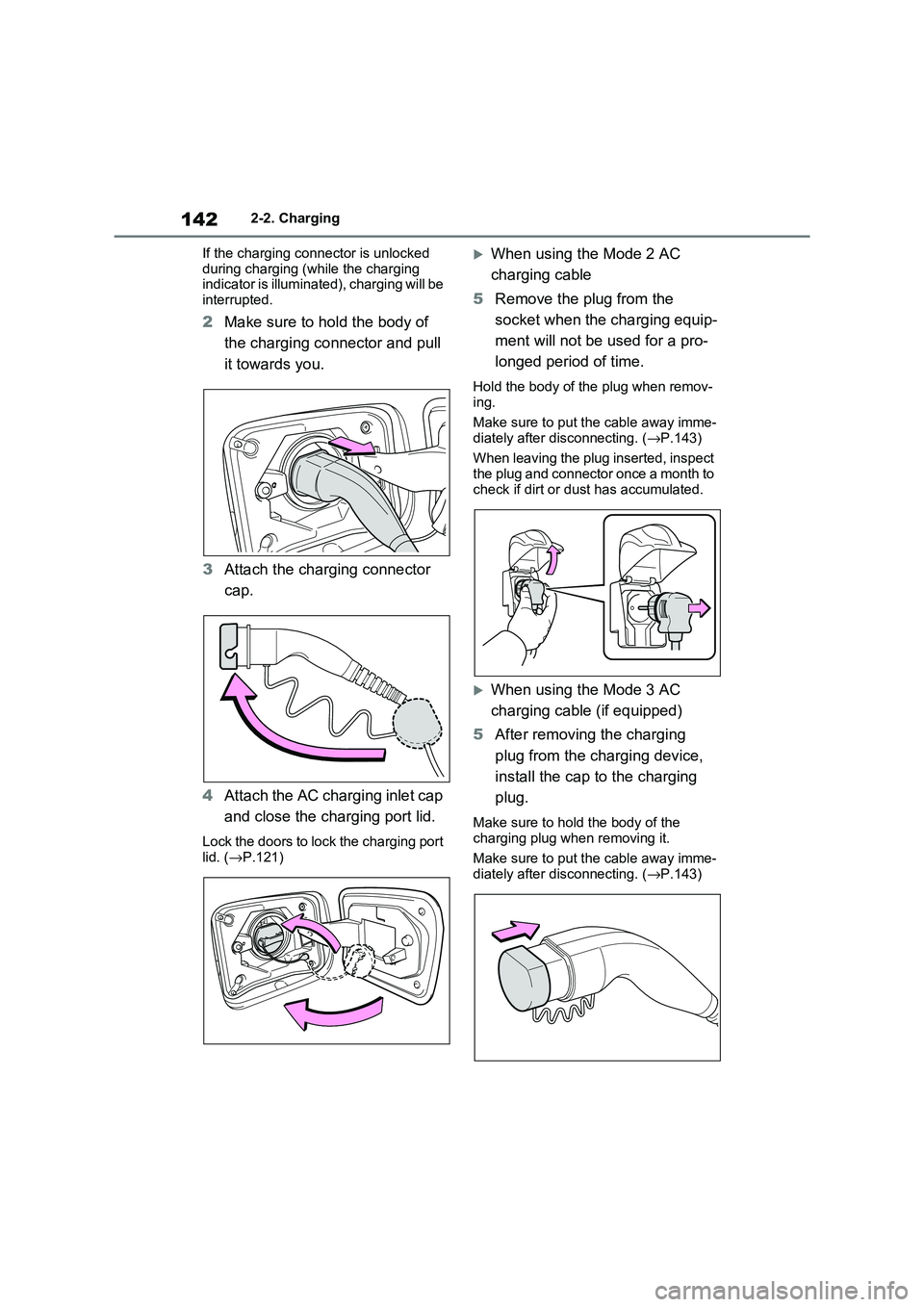
1422-2. Charging
If the charging connector is unlocked
during charging (while the charging indicator is illuminated), charging will be
interrupted.
2 Make sure to hold the body of
the charging connector and pull
it towards you.
3 Attach the charging connector
cap.
4 Attach the AC charging inlet cap
and close the charging port lid.
Lock the doors to lock the charging port lid. ( →P.121)
When using the Mode 2 AC
charging cable
5 Remove the plug from the
socket when the charging equip -
ment will not be used for a pro -
longed period of time.
Hold the body of the plug when remov -
ing.
Make sure to put the cable away imme - diately after disconnecting. ( →P.143)
When leaving the plug inserted, inspect
the plug and connector once a month to check if dirt or d ust has accumulated.
When using the Mode 3 AC
charging cable (if equipped)
5 After removing the charging
plug from the charging device,
install the cap to the charging
plug.
Make sure to hold the body of the
charging plug when removing it.
Make sure to put the cable away imme -
diately after disconnecting. ( →P.143)
Page 145 of 666
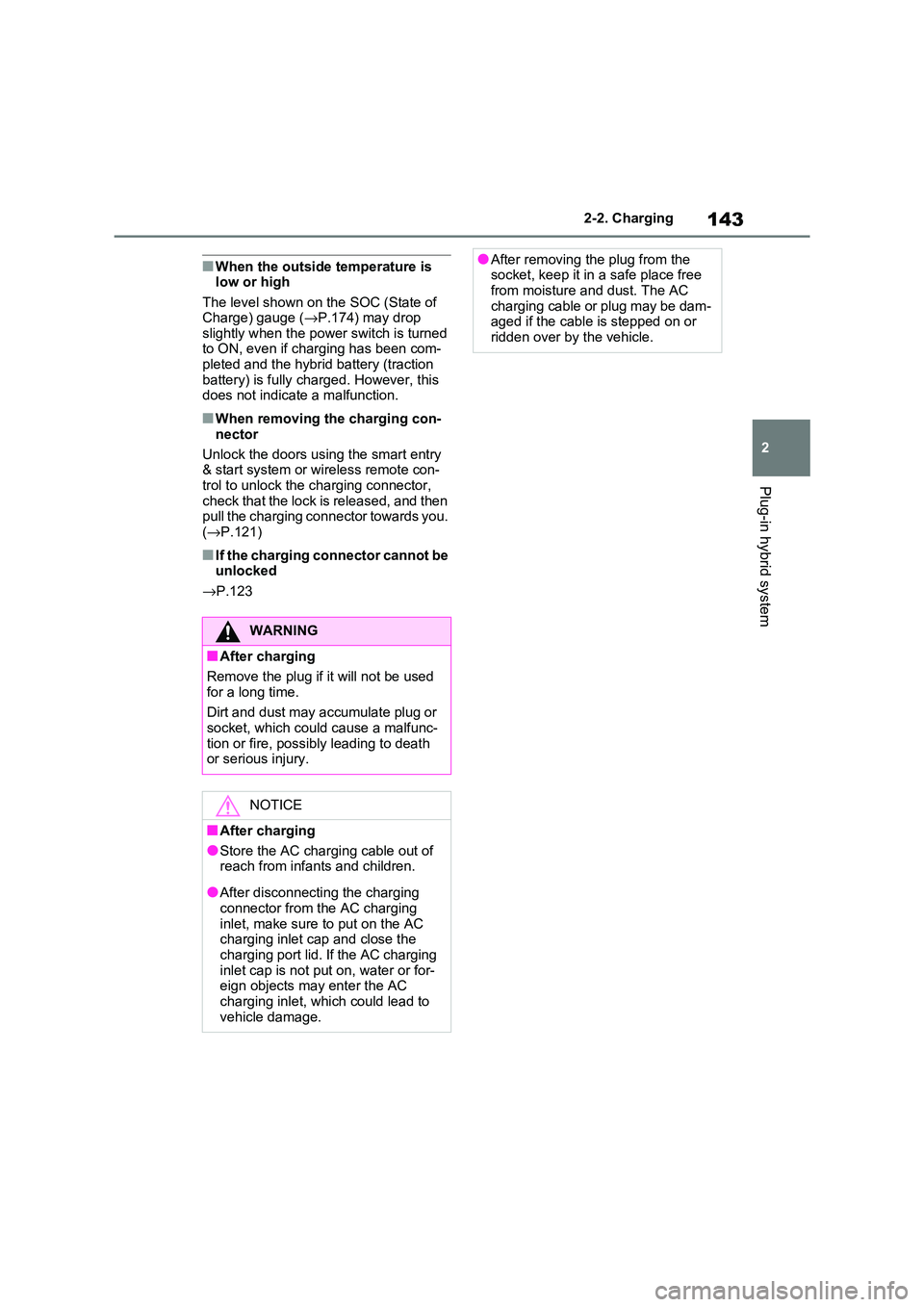
143
2
2-2. Charging
Plug-in hybrid system
■When the outside temperature is low or high
The level shown on the SOC (State of
Charge) gauge ( →P.174) may drop slightly when the power switch is turned
to ON, even if charging has been com -
pleted and the hybrid battery (traction battery) is fully charged. However, this
does not indicate a malfunction.
■When removing the charging con -
nector
Unlock the doors using the smart entry
& start system or wir eless remote con-
trol to unlock the ch arging connector, check that the lock is released, and then
pull the charging connector towards you.
( →P.121)
■If the charging connector cannot be unlocked
→ P.123
WARNING
■After charging
Remove the plug if it will not be used for a long time.
Dirt and dust may accumulate plug or
socket, which could cause a malfunc - tion or fire, possibly leading to death
or serious injury.
NOTICE
■After charging
●Store the AC charging cable out of
reach from infants and children.
●After disconnecting the charging
connector from the AC charging
inlet, make sure t o put on the AC charging inlet cap and close the
charging port lid. If the AC charging
inlet cap is not put on, water or for- eign objects may enter the AC
charging inlet, which could lead to
vehicle damage.
●After removing the plug from the socket, keep it in a safe place free
from moisture and dust. The AC
charging cable or plug may be dam - aged if the cable i s stepped on or
ridden over by the vehicle.
Page 146 of 666
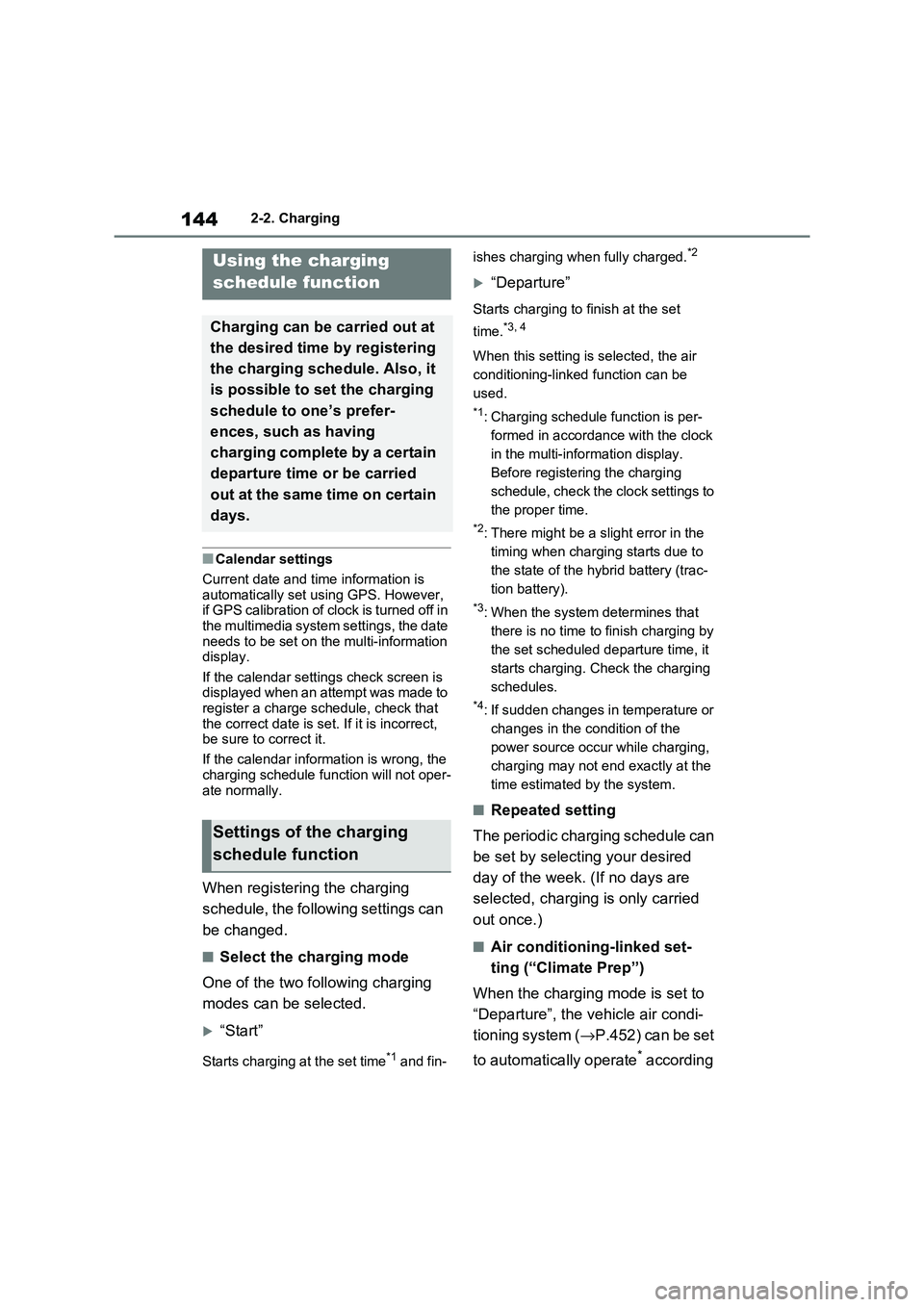
1442-2. Charging
■Calendar settings
Current date and tim e information is
automatically set u sing GPS. However, if GPS calibration of clock is turned off in
the multimedia system s ettings, the date
needs to be set on t he multi-information display.
If the calendar settings check screen is
displayed when an attempt was made to register a charge schedule, check that
the correct date is set. If it is incorrect,
be sure to correct it.
If the calendar information is wrong, the
charging schedule function will not oper -
ate normally.
When registering the charging
schedule, the following settings can
be changed.
■Select the charging mode
One of the two following charging
modes can be selected.
“Start”
Starts charging at the set time*1 and fin -
ishes charging when fully charged.*2
“Departure”
Starts charging to finish at the set
time.*3, 4
When this setting is selected, the air
conditioning-linked function can be
used.
*1: Charging schedule function is per -
formed in accordance with the clock
in the multi-information display.
Before registering the charging
schedule, check the clock settings to
the proper time.
*2: There might be a slight error in the
timing when charging starts due to
the state of the hy brid battery (trac-
tion battery).
*3: When the system d etermines that
there is no time to finish charging by
the set scheduled departure time, it
starts charging. Check the charging
schedules.
*4: If sudden changes in temperature or
changes in the condition of the
power source occur while charging,
charging may not end exactly at the
time estimated by the system.
■Repeated setting
The periodic charging schedule can
be set by select ing your desired
day of the week. (If no days are
selected, charging is only carried
out once.)
■Air conditioning-linked set -
ting (“Climate Prep”)
When the charging mode is set to
“Departure”, the vehicle air condi -
tioning system ( →P.452) can be set
to automatically operate* according
Using the charging
schedule function
Charging can be carried out at
the desired time by registering
the charging schedule. Also, it
is possible to set the charging
schedule to one’s prefer -
ences, such as having
charging complete by a certain
departure time or be carried
out at the same time on certain
days.
Settings of the charging
schedule function
Page 147 of 666
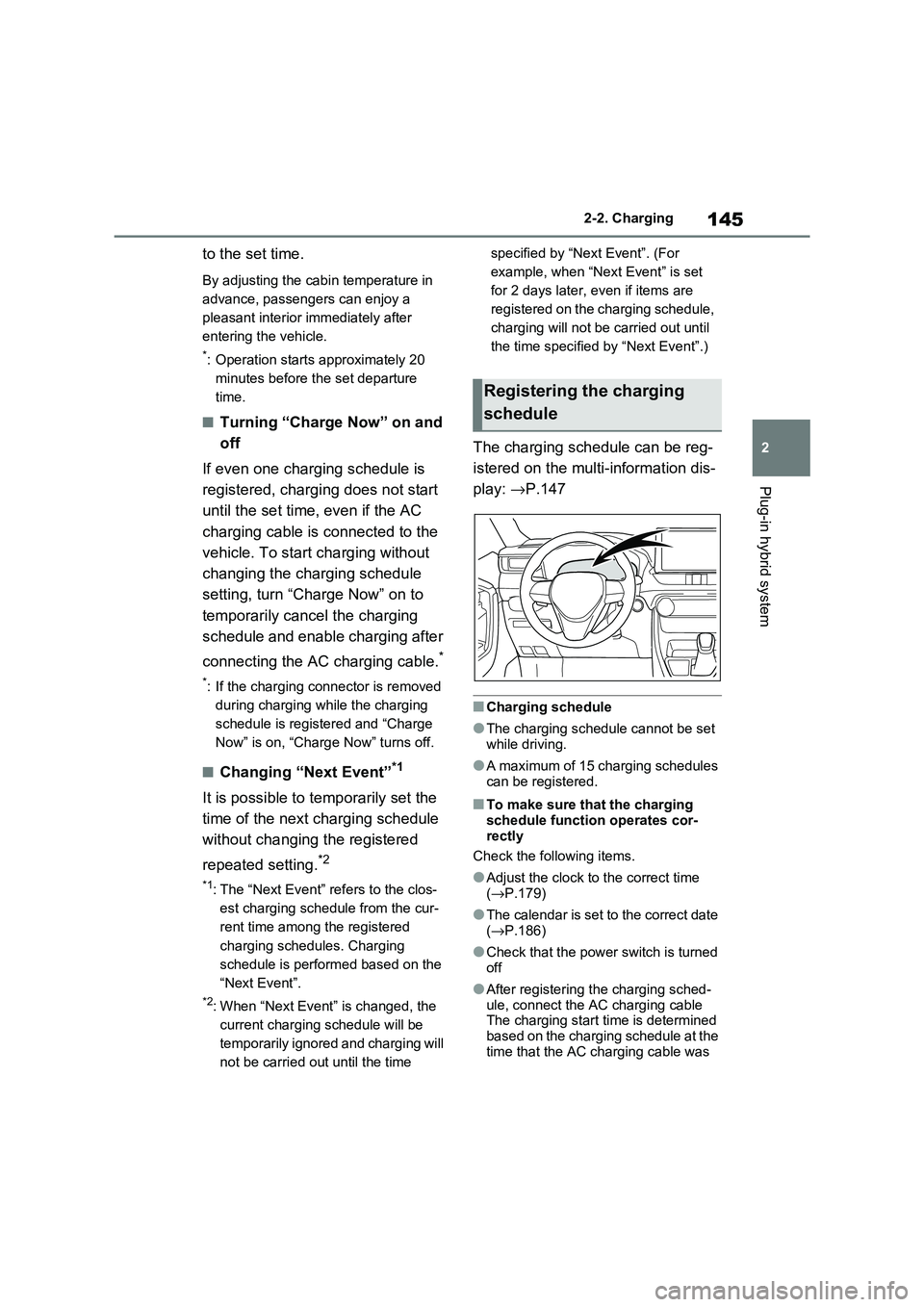
145
2
2-2. Charging
Plug-in hybrid system
to the set time.
By adjusting the cabi n temperature in
advance, passengers can enjoy a
pleasant interior immediately after
entering the vehicle.
*: Operation starts approximately 20
minutes before the set departure
time.
■Turning “Charge Now” on and
off
If even one charging schedule is
registered, charging does not start
until the set time, even if the AC
charging cable is connected to the
vehicle. To start c harging without
changing the charging schedule
setting, turn “Charge Now” on to
temporarily cancel the charging
schedule and enable charging after
connecting the AC charging cable.*
*: If the charging connector is removed
during charging while the charging
schedule is registered and “Charge
Now” is on, “Charg e Now” turns off.
■Changing “Next Event”*1
It is possible to temporarily set the
time of the next charging schedule
without changing the registered
repeated setting.*2
*1: The “Next Event” refers to the clos -
est charging sched ule from the cur-
rent time among t he registered
charging schedules. Charging
schedule is performed based on the
“Next Event”.
*2: When “Next Event” is changed, the
current charging schedule will be
temporarily ignored and charging will
not be carried out until the time
specified by “Ne xt Event”. (For
example, when “Nex t Event” is set
for 2 days later, e ven if items are
registered on the charging schedule,
charging will not be carried out until
the time specified by “Next Event”.)
The charging schedule can be reg-
istered on the multi-information dis -
play: →P.147
■Charging schedule
●The charging schedule cannot be set while driving.
●A maximum of 15 charging schedules can be registered.
■To make sure that the charging
schedule function operates cor -
rectly
Check the following items.
●Adjust the clock to the correct time ( →P.179)
●The calendar is set to the correct date
( →P.186)
●Check that the power switch is turned
off
●After registering the charging sched-
ule, connect the AC charging cable The charging start time is determined
based on the charging schedule at the
time that the AC charging cable was
Registering the charging
schedule
Page 148 of 666
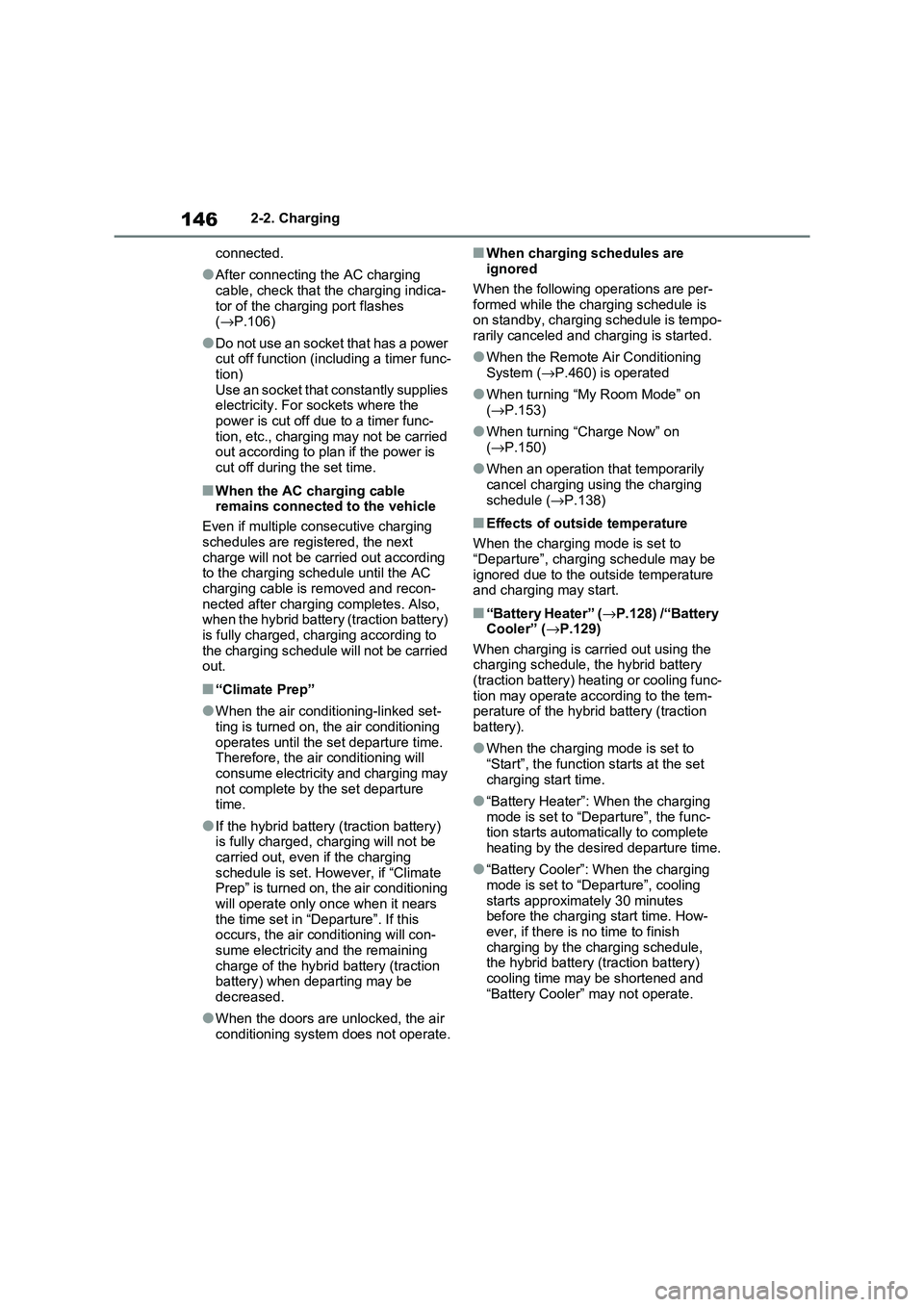
1462-2. Charging
connected.
●After connecting the AC charging
cable, check that the charging indica -
tor of the charging port flashes ( →P.106)
●Do not use an socket that has a power cut off function (including a timer func -
tion)
Use an socket that constantly supplies electricity. For sockets where the
power is cut off due to a timer func -
tion, etc., charging may not be carried out according to plan if the power is
cut off during the set time.
■When the AC charging cable
remains connected to the vehicle
Even if multiple consecutive charging
schedules are registered, the next
charge will not be ca rried out according to the charging schedule until the AC
charging cable is removed and recon-
nected after charging completes. Also, when the hybrid battery (traction battery)
is fully charged, charging according to
the charging schedule will not be carried out.
■“Climate Prep”
●When the air condit ioning-linked set- ting is turned on, the air conditioning
operates until the se t departure time.
Therefore, the air conditioning will consume electricity and charging may
not complete by the set departure
time.
●If the hybrid battery (traction battery)
is fully charged, cha rging will not be carried out, even if the charging
schedule is set. However, if “Climate
Prep” is turned on, the air conditioning will operate only once when it nears
the time set in “De parture”. If this
occurs, the air conditioning will con -
sume electricity and the remaining charge of the hybrid battery (traction
battery) when departing may be
decreased.
●When the doors are unlocked, the air
conditioning system does not operate.
■When charging schedules are
ignored
When the following operations are per -
formed while the charging schedule is
on standby, charging schedule is tempo - rarily canceled and charging is started.
●When the Remote Air Conditioning System ( →P.460) is operated
●When turning “My Room Mode” on ( →P.153)
●When turning “Charge Now” on ( →P.150)
●When an operation that temporarily cancel charging using the charging
schedule ( →P.138)
■Effects of outside temperature
When the charging mode is set to “Departure”, chargin g schedule may be
ignored due to the outside temperature
and charging may start.
■“Battery Heater” ( →P.128) /“Battery Cooler” ( →P.129)
When charging is carried out using the
charging schedule, the hybrid battery (traction battery) heating or cooling func -
tion may operate according to the tem -
perature of the hybrid battery (traction battery).
●When the charging mode is set to “Start”, the function starts at the set
charging start time.
●“Battery Heater”: When the charging
mode is set to “Dep arture”, the func-
tion starts automatic ally to complete heating by the desired departure time.
●“Battery Cooler”: When the charging mode is set to “Dep arture”, cooling
starts approximately 30 minutes
before the charging start time. How -
ever, if there is no time to finish charging by the charging schedule,
the hybrid battery (traction battery)
cooling time may be shortened and “Battery Cooler” may not operate.
Page 149 of 666
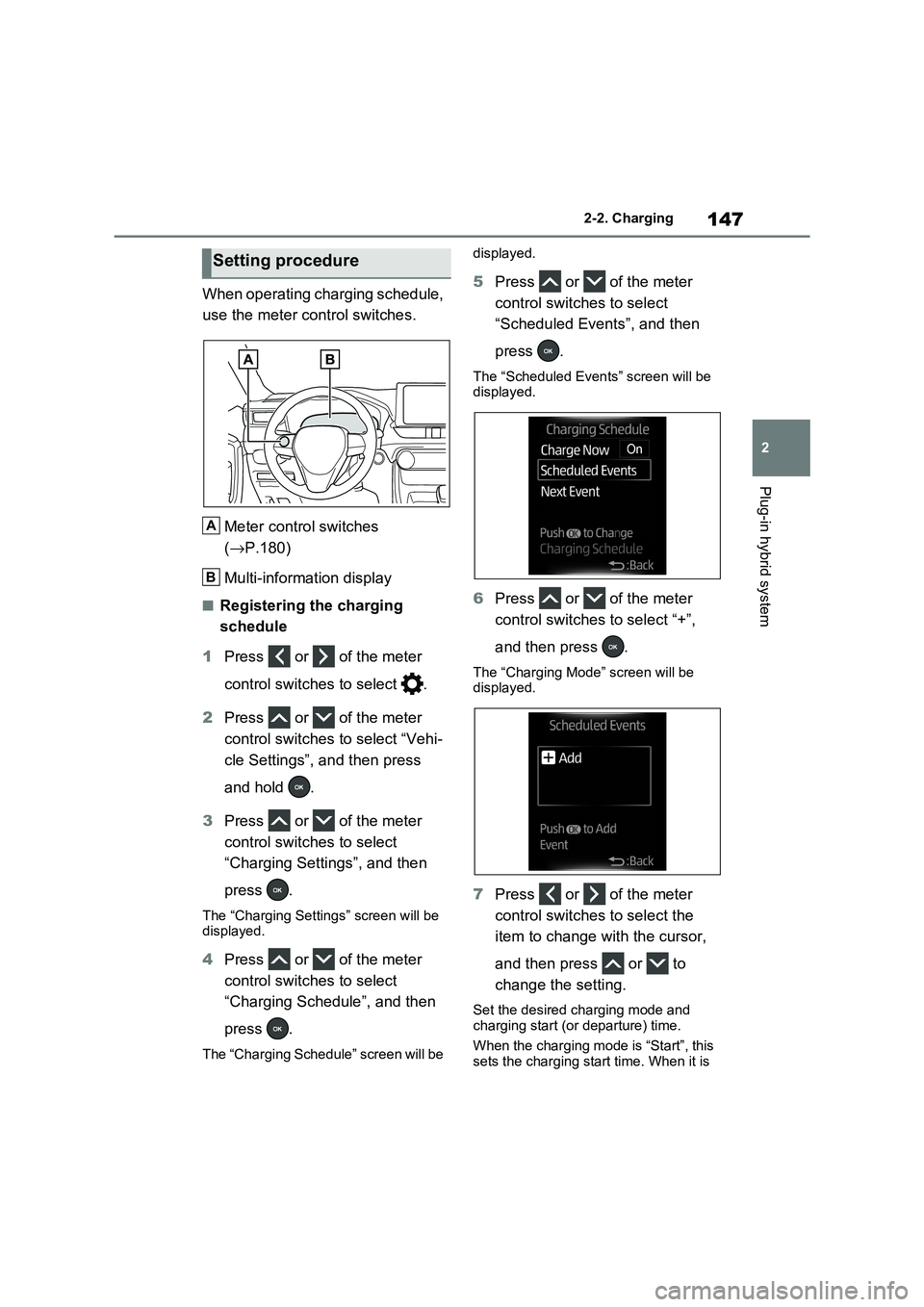
147
2
2-2. Charging
Plug-in hybrid system
When operating charging schedule,
use the meter co ntrol switches.
Meter control switches
( →P.180)
Multi-information display
■Registering the charging
schedule
1 Press or of the meter
control switches to select .
2 Press or of the meter
control switches to select “Vehi -
cle Settings”, and then press
and hold .
3 Press or of the meter
control switches to select
“Charging Settings”, and then
press .
The “Charging Settings” screen will be
displayed.
4 Press or of the meter
control switches to select
“Charging Schedule”, and then
press .
The “Charging Schedule” screen will be
displayed.
5 Press or of the meter
control switches to select
“Scheduled Events”, and then
press .
The “Scheduled Even ts” screen will be
displayed.
6 Press or of the meter
control switches to select “+”,
and then press .
The “Charging Mode” screen will be displayed.
7 Press or of the meter
control switches to select the
item to change with the cursor,
and then press or to
change the setting.
Set the desired charging mode and charging start (or departure) time.
When the charging mode is “Start”, this
sets the charging start time. When it is
Setting procedure
A
B
Page 150 of 666
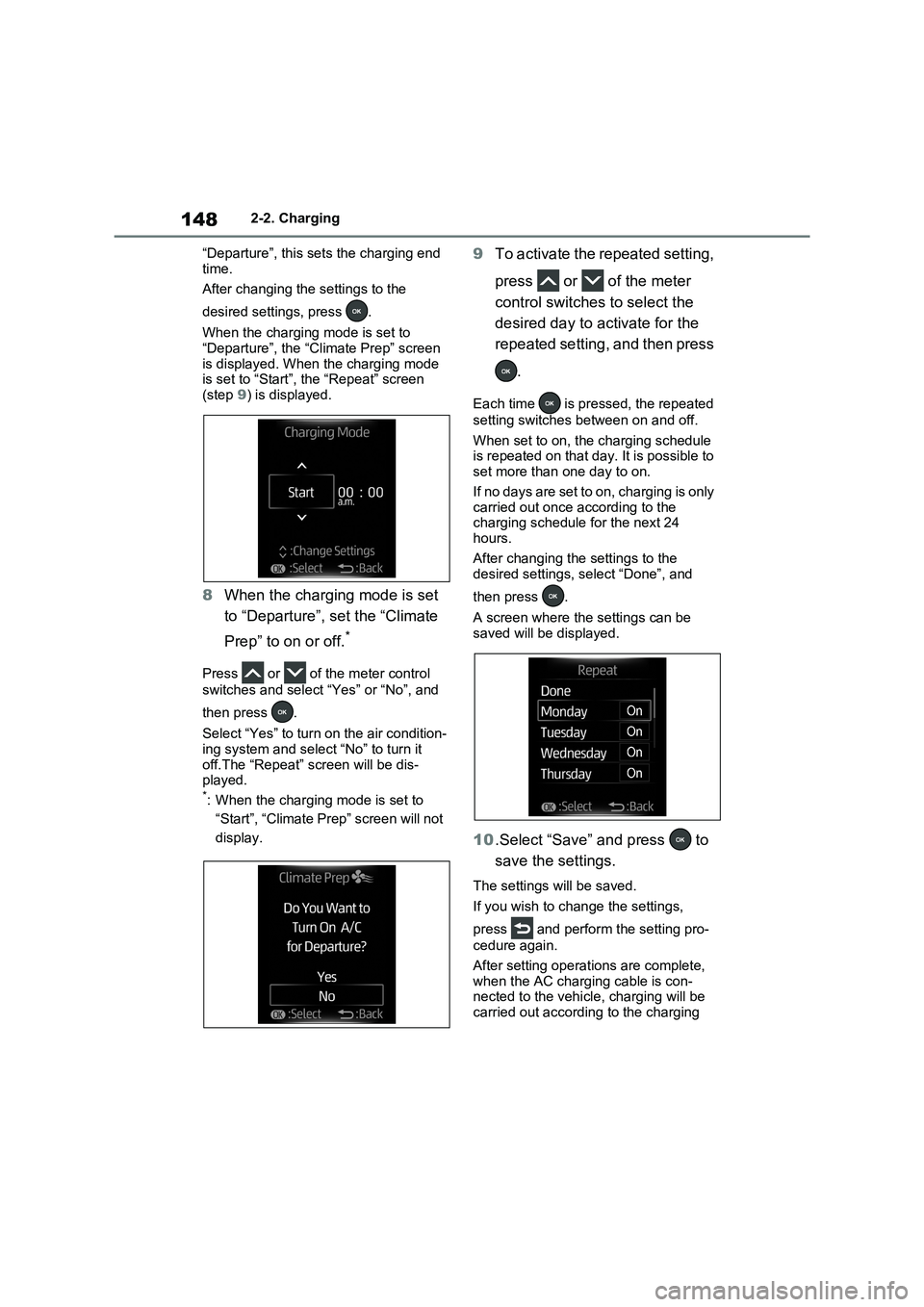
1482-2. Charging
“Departure”, this sets the charging end
time.
After changing the settings to the
desired setti ngs, press .
When the charging mode is set to “Departure”, the “Cl imate Prep” screen
is displayed. When the charging mode
is set to “Start”, the “Repeat” screen (step 9) is displayed.
8When the charging mode is set
to “Departure”, set the “Climate
Prep” to on or off.*
Press or of the meter control
switches and select “Yes” or “No”, and
then press .
Select “Yes” to turn on the air condition - ing system and selec t “No” to turn it
off.The “Repeat” screen will be dis -
played.*: When the charging mode is set to
“Start”, “Climate Prep” screen will not
display.
9 To activate the repeated setting,
press or of the meter
control switches to select the
desired day to activate for the
repeated setting, and then press
.
Each time is pressed, the repeated
setting switches between on and off.
When set to on, th e charging schedule is repeated on that day. It is possible to
set more than one day to on.
If no days are set to on, charging is only carried out once according to the
charging schedule for the next 24
hours.
After changing the settings to the
desired settings, select “Done”, and
then press .
A screen where the settings can be saved will be displayed.
10 .Select “Save” and press to
save the settings.
The settings will be saved.
If you wish to chan ge the settings,
press and perform the setting pro -
cedure again.
After setting operatio ns are complete,
when the AC charging cable is con - nected to the vehicl e, charging will be
carried out according to the charging